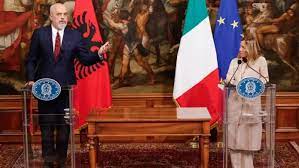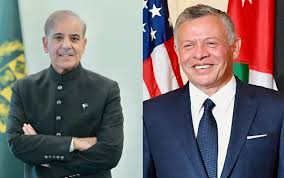Italy to build detention hubs in Albania: What do they mean for migrants?

Rome: Crowds of African “boat people” overfill a centre for welcoming migrants in a small harbour town on the Italian island of Lampedusa.
Many wrapped in metallic emergency blankets, others reclining on makeshift cots, the people are awaiting documentation, upon which they will be sent to another, larger camp in Sicily.
“Lampedusa is stretched beyond capacity,” says Francesca Basile, a spokeswoman for the Italian Red Cross on Lampedusa.
More than 145,000 migrants from Africa have landed in south Italy so far in 2023, compared to around 88,000 in 2022.
Such scenes are an embarrassment for Italy’s new right-wing government, which came to power last year largely on promises to curb illegal migration and steer African migrants away from Italian shores.
Italian Prime Minister Giorgia Meloni now has a novel plan — the burden of housing and processing African migrants destined for Italy will be transferred to Albania.
The new scheme was unveiled earlier this month by Meloni and her Albanian counterpart Prime Minister Edi Rama. Under the scheme, Italy will build and staff immigrant detention camps in Albania to house Italy-bound African immigrants intercepted at sea en route by the Italian navy and coast guard.
Meloni announced that two camps, euphemistically called “reception centres”, would handle “a total annual flow of 36,000 people”. The two camps will likely become fully operational by spring 2024.
The surprising decision, which was made public suddenly without any prior public debate in either Italy or Albania, is fraught with controversy and has been met with resistance by Italian opposition politicians, international rights groups, as well as broad segments of the Albanian media and the population at large in Albania.
Meloni and her Brothers of Italy party have been seen to be failing to make good on their campaign promises to stem the seemingly unstoppable flow of African immigrants from Tunisia and Libya landing on Lampedusa.
Meloni has threatened to impose naval blockades against migrant boats and has introduced rules against rescue ships operated by non-governmental organisations, which she has accused of working in conjunction with human traffickers.
In April, Italian ministers declared a six-month state of emergency in response to the rising numbers of migrants crossing the Mediterranean from North Africa — up 65 percent from last year.
One of the two proposed camps will be set up in the north Albanian coastal town of Shengjin and serve as a scanning and registration point for asylum-seekers headed to the EU.
Ensuing asylum application procedures will be conducted in a repatriation centre further inland, in Gjader, the site of a former military airport. The two camps will be maintained by Italy “in full compliance with the European Union and international law,” according to Meloni.
Migrants whose applications are rejected will be sent back to their countries of origin.
While Albania’s offer has come out of the blue for many, the issue of camps housing migrants bound for the EU being set up in non-EU countries – including Albania – has been bandied about for some time now.
A similar controversial proposal – known as the “Rwandan model” — was drawn up by the British government, whereby thousands of asylum-seekers would be flown to Rwanda, where their asylum applications would be examined.
In its hope to keep new arrivals at arm’s length, the UK did, however, construct a giant 222-room, three-story “migrant barge” off the south coast of England for migrants unwanted on British soil. The plan has been criticised for the inhumane conditions in which people are detained, as well as being a fire hazard and public health risk.





